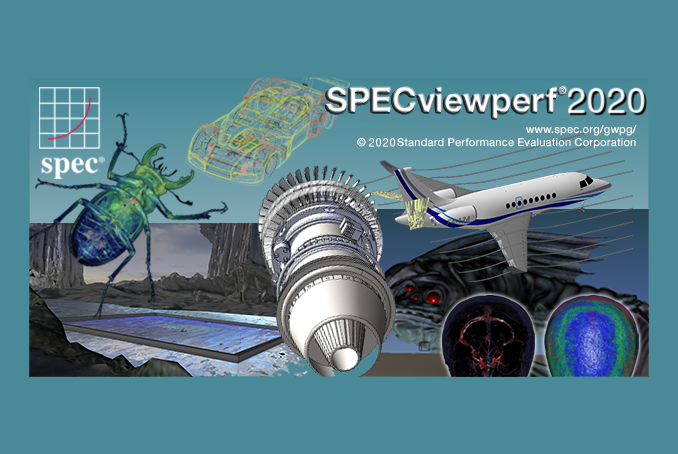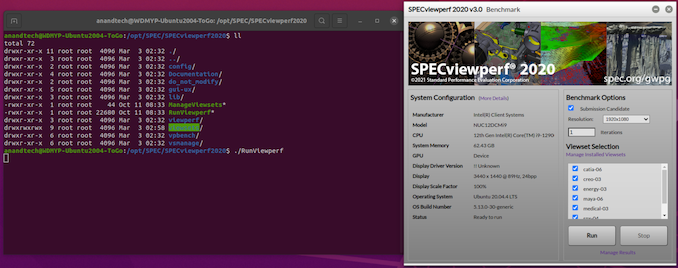SPEC Adds Linux Edition of SPECviewperf 2020 v3.0 Benchmark
by Ganesh T S on March 3, 2022 6:30 AM EST- Posted in
- GPUs
- Systems
- Linux
- Benchmarks
- SPEC
- SPECviewperf
- SPECgpc

The SPEC Graphics Performance Characterization (SPECgpc) group updated the Windows version of the workstation GPU benchmark suite - SPECviewperf 2020 - twice last year. The intent of the benchmark is to replay GPU workload traces from real-world professional applications (Maya for media and entertainment, Catia, Creo, NX, and Solidworks for CAD/CAM, OpendTect for the energy industry, and the Tuvok visualization library for rendering medical images). Version 3.0, released in December 2021, updated the Solidworks viewset to better reflect the OpenGL API calls in the latest version of the software. Version 2.0 had enabled selective downloading of the viewsets.
While the Windows version of the benchmark had been through three versions, the Linux community was left out, having to rely on the SPECviewperf 13 released almost a decade ago. That is changing today with the availability of the Linux edition of SPECviewperf 2020 v3.0. The benchmark updates the viewsets with traces from the latest versions of the relevant applications and also updates the models to match the Windows version. Since the benchmarks wrapper framework (even for the Windows version) is based on Node-Webkit (now NW.js), the creation of a Linux edition had to mainly deal with the actual viewset processing. Automation and results processing are identical between the Windows and Linux versions.
Unlike SPECviewperf 13 Linux Edition which was distributed as a compressed tar archive, the SPECviewperf 2020 v3.0 Linux Edition is a .deb package. The benchmark requires Canonical Ubuntu Linux 20.04, 16GB or more of RAM, and 80GB of fixed disk drive space. Viewsets are processed at two resolutions - 1080p and 4K, with 1080p being the minimum. The GPU drivers are required to support OpenGL 4.5, and the GPU itself needs to have 2GB minimum VRAM.
The benchmark is available for download free of cost for everyone other than vendors of computers and related products / services who are not members of SPEC/GWPG. Such vendors can purchase a license for $2500.
Linux has a much greater market share in the workstation segment compared to consumer desktops. It is heartening to see SPECgpc finally replace the aging Linux edition of SPECviewperf 13 . The latest viewsets and models in the SPECviewperf 2020 v3.0 Linux Edition bring it on par with the benchmarking capabilities of the Windows edition.
Source: SPEC











12 Comments
View All Comments
duvjones - Thursday, March 3, 2022 - link
Just Ubuntu... Are they serious?kgardas - Thursday, March 3, 2022 - link
I think Ubuntu is expected and good option indeed. RHEL/SuSE are more server oriented and here you'd like to benchmark CAD stations -> Ubuntu.Kangal - Thursday, March 3, 2022 - link
They are probably targeting the Stable Debian build.Mentioning the specific Ubuntu version is probably a way to simplify it for people. Although I traditionally favoured Suse, in the last decade I've somewhat swung the opposite way, and actually not a fan of Linux as I used to be (iOS, OS X, Windows, and even iOS has come very far).
tuxRoller - Tuesday, March 8, 2022 - link
RH has an awfully large desktop subscriber base. Obviously the vast majority are used for traditional workstation tasks, and in those cases nearly all of the clients are running apps certified for rhel. You'll often see rhel & suse being supported while Ubuntu trails by a pretty significant margin. It's all pretty niche, and, I'd imagine, Ubuntu fares much better when looking at the unsupported business desktop market.AdrianBc - Thursday, March 3, 2022 - link
On any other distribution one might need to waste some time to find and install some shared libraries with versions matching those of Ubuntu, but in any case the benchmark will run eventually.The advantage of Linux is precisely that with more or less effort anything can be done, while on Windows there are cases when you are stuck with problems that are impossible to solve.
AdrianBc - Friday, March 4, 2022 - link
After writing the reply above, I have downloaded SPECviewperf for Linux and I have tried it on a Gentoo Linux, instead of the Ubuntu Linux.For some reason, the Chrome-based user interface could not download the benchmark data sets, due to some certificate problem. Maybe it searches for certificates in a certain place, which is not the same for Ubuntu and Gentoo.
To work around this issue, I have found in their download script the directory with the "viewsets", I have downloaded manually from there the archive files with the suffix ".ux.3.0.7z", which are meant for Linux and I have extracted them into the directory "/opt/SPEC/SPECviewperf2020/viewsets".
After this, I was able to run all the benchmarks flawlessly, without any other problems.
Soulkeeper - Saturday, March 5, 2022 - link
I agree, I'm tired of this distro favoratism.Just release tarballs and let the package maintainers handle the rest for their distros.
We need distro agnostic approaches. I get that they want to guarantee/certify that a certain distro works, but it hurts others.
ballsystemlord - Sunday, March 6, 2022 - link
I 2nd the motion. Tar balls would be best here.brucethemoose - Tuesday, March 8, 2022 - link
It already exist. They're called appimages, and they're more-ore-less the analogue to portable Windows .exes.TBH, releasing an app as a .deb only makes it seem like the dev is stuck in the previous decade. Debian based systems aren't as standard as they used to be.
TheinsanegamerN - Tuesday, April 5, 2022 - link
the linux community cant agree on any standardization, and nobody is going to release software with no way to guarantee that it works without third party maintainers.